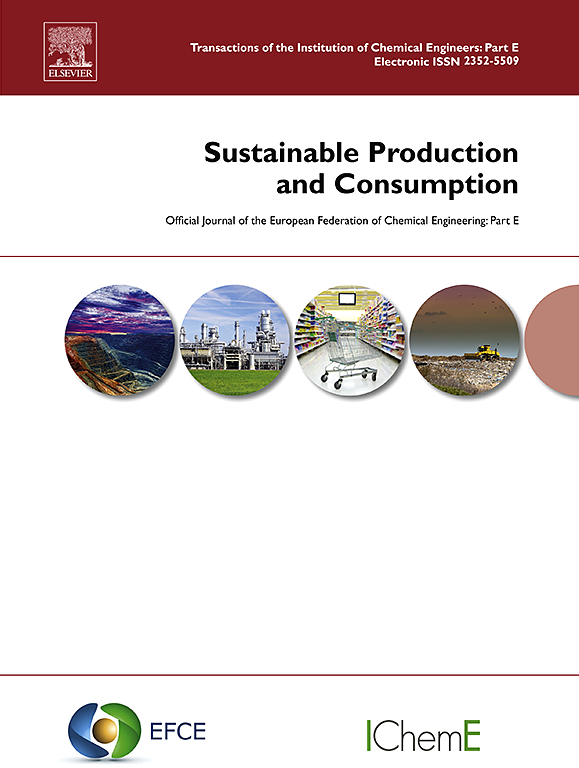System-level analysis of strategies for biodegradable plastics production from microalgae
IF 10.9
1区 环境科学与生态学
Q1 ENVIRONMENTAL STUDIES
引用次数: 0
Abstract
Fossil-fuel-based plastics have contributed significantly to global warming and marine pollution, both during their production and disposal. As a viable alternative, microalgae-based biodegradable plastics offer an environmentally sustainable solution owing to the rapid growth of microalgae and their ability to absorb CO2. However, the high price of bioplastics hinders their widespread adoption as a replacement for conventional plastics. In this study, an integrated process (Case 1) for coproducing lactic acid (LA, a monomer of polylactic acid), polyurethane, and azelaic acid (AA), by fully utilizing the major components of microalgae (carbohydrates, triglycerides, and free fatty acids (FFAs)) is proposed. This method significantly improves the economics of bioplastic production. Apart from AA production from FFAs, which is a common process to produce LA and polyurethane, two additional cases are also presented to investigate the environmental and economic impact of FFA utilization: Case 2 consumed FFAs as a heat source and Case 3 externally disposed of FFAs. Comprehensive analyses, including techno-economic analysis and life cycle assessment, were conducted to identify the economic and environmental benefits of the three cases. Case 1 is the most economically advantageous option, with the lowest minimum selling price (MSP) of $1017/ton-LA due to additional revenue from the sales of AA, which is a valuable product. Despite its economic benefit, Case 1 is not environmentally favorable (6.6 kg CO2 eq./kg-LA). In contrast, Case 2 has the lowest global warming potential (2.3 kg CO2 eq./kg-LA), equivalent to an annual reduction of 135,865 metric tons of CO2 emissions in comparison to the conventional LA production process (4.8 kg CO2 eq./kg-LA); conversely, it has the highest MSP of $1605/ton-LA. This denotes that the proposed process can reduce annual 135,865 tons of CO2 with competitive price compared to the conventional LA ($1100-1940/ton). The results highlight the inherent tradeoff between economic and environmental viability and provide valuable insights into the commercial development of renewable biodegradable plastics.
微藻生物降解塑料生产策略的系统级分析
基于化石燃料的塑料在生产和处理过程中都对全球变暖和海洋污染做出了重大贡献。作为一种可行的替代方案,基于微藻的可生物降解塑料提供了一种环境可持续的解决方案,因为微藻的快速生长和它们吸收二氧化碳的能力。然而,生物塑料的高价格阻碍了它们作为传统塑料替代品的广泛采用。本研究提出了一种综合工艺(案例1),充分利用微藻的主要成分(碳水化合物、甘油三酯和游离脂肪酸),共产乳酸(聚乳酸的单体LA)、聚氨酯和壬二酸(AA)。这种方法显著提高了生物塑料生产的经济性。除了从FFAs中生产AA(这是生产LA和聚氨酯的常见过程)之外,还提出了另外两个案例来研究FFA利用的环境和经济影响:案例2将FFAs作为热源消耗,案例3将FFAs外部处理。通过技术经济分析和生命周期评价等综合分析,确定了三个案例的经济效益和环境效益。Case 1是经济上最有利的选择,最低销售价格(MSP)为$1017/t - la,这是由于销售AA的额外收入,这是一个有价值的产品。尽管具有经济效益,但情况1对环境不利(6.6 kg CO2当量/kg- la)。相比之下,情况2具有最低的全球变暖潜能值(2.3 kg CO2当量/kg-LA),与传统的LA生产过程(4.8 kg CO2当量/kg-LA)相比,相当于每年减少135,865公吨二氧化碳排放量;相反,它的MSP最高,为1605美元/吨。这表明,与传统的LA(1100-1940美元/吨)相比,拟议的工艺每年可减少135,865吨二氧化碳,价格具有竞争力。研究结果强调了经济和环境可行性之间的内在权衡,并为可再生生物降解塑料的商业开发提供了有价值的见解。
本文章由计算机程序翻译,如有差异,请以英文原文为准。
求助全文
约1分钟内获得全文
求助全文
来源期刊

Sustainable Production and Consumption
Environmental Science-Environmental Engineering
CiteScore
17.40
自引率
7.40%
发文量
389
审稿时长
13 days
期刊介绍:
Sustainable production and consumption refers to the production and utilization of goods and services in a way that benefits society, is economically viable, and has minimal environmental impact throughout its entire lifespan. Our journal is dedicated to publishing top-notch interdisciplinary research and practical studies in this emerging field. We take a distinctive approach by examining the interplay between technology, consumption patterns, and policy to identify sustainable solutions for both production and consumption systems.
 求助内容:
求助内容: 应助结果提醒方式:
应助结果提醒方式:


